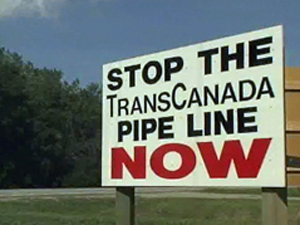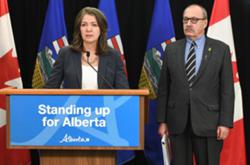
A Calgary-based pipeline company could soon start shipping Canadian oil across one of the biggest freshwater aquifers in the world -- part of a proposed fossil fuel mega-highway from Alberta to Texas.
Critics worry that a major leak could ruin drinking water for millions of Americans and devastate the mid-western U.S. economy.
The project developer, TransCanada, has applied for special permits to build its Keystone XL pipeline with thinner-than-normal steel, possibly saving the company more than a billion dollars.
A fast-growing body of ranchers, farmers, green groups, U.S. senators and even the CEO of Google wonders whether the project's risk is worth it -- especially as crude spewing from BP's ruptured offshore rig coats white sand beaches black along the Florida coastline.
Add to their concerns that portions of the pipeline will cross an active earthquake zone. And despite the promises of pipeline company executives, big leaks happen every year.
If TransCanada gets U.S. regulatory approval, crude from Alberta's much-maligned oil sands could start oozing south as early as 2013 (see map of proposed pipeline route by clicking here).
The company has stressed repeatedly that it's committed to the highest safety standards -- that comparisons to the environmental catastrophe in the Gulf of Mexico are "completely unfair."
Yet critics see little distinction. "BP didn't think their well would ever leak," Cindy Kreifels, executive vice president of the Nebraska-based Groundwater Foundation told The Tyee. "They supposedly had disaster plans in place and it has not made a difference."
Vital water source threatened?
Earlier this month, U.S. officials extended the public comment period for Keystone XL by two weeks -- the second extension so far.
Opponents have been growing in size, stature and volume as TransCanada seeks approval to build a pipeline from Hardisty, Alberta, to Gulf Coast refineries in Texas. The proposed conduit is phase two of a US$12 billion TransCanada energy corridor. Phase One -- known simply as Keystone -- is largely built, and crude from Alberta's oil sands has already started flowing to Illinois.
The Keystone XL portion would cross six mid-western states on its journey south. If completed, the entire system -- phases one and two -- could transport 1.1 million barrels of Alberta fuel a day, close to the full output of that province's oil sands industry.
In a series of public hearings over recent weeks, farmers and ranchers have fretted about potential leaks along the pipeline's 3,200 kilometre route. (Watch a video news report featuring some of those farmers in South Dakota here.)
The stakes are extremely high. Keystone XL would plough across the north-eastern tip of the Ogallala aquifer as it traversed Nebraska. The Ogallala is one of the largest sources of fresh groundwater on Earth, spanning eight states and providing drinking water for two million people.
More than $20 billion worth of crops -- including corn, wheat, sorghum and cotton -- depend on it. And in Nebraska, where one third of the workforce is directly employed in agricultural industries, the Ogallala is an economic lynchpin.
Locals take great pride in their aquifer, Kreifels said, sometimes referring to it as Nebraska's "Rocky Mountains."
"It's considered a prize resource. If we don't take care of it, it would be very difficult to live in this state," she said.
Earthquakes and leaky pipes
Several factors compound the danger of building a pipeline across the Ogallala, according to green groups opposed to the project.
"Some portions of the aquifer are so close to the surface that any pipeline leak would almost immediately contaminate a large portion of the water," reads a recent report from the Nebraska Wildlife Federation.
Because groundwater drips through sand, clay, and gravel, cleanup could become a logistical nightmare. Nebraska also sits atop an active seismic zone, where earthquakes -- one at a 4.3 magnitude in 2002 -- and tremors shake the ground.
And critics note that despite the best efforts of pipeline operators, leaks are inevitable. Just last week, a Chevron pipeline spilled 33,000 gallons of oil from a "quarter-size" hole into a Salt Lake City creek.
This May, the Trans-Alaska Pipeline spewed thousands of barrels of crude near Fairbanks, Alaska -- the same pipeline that leaked 267,000 gallons four years ago.
TransCanada has applied for special permits from the U.S. government to build Keystone XL with thinner steel than required and pump oil at higher pressures. The Pipeline Safety Trust, an independent oversight group, estimated the company has the "potential to save many hundreds of millions of dollars, possibly exceeding a billion dollars."
The trust didn't see any safety issue, as long as regulators force TransCanada to be extra vigilant. That could mean inspecting 100 per cent of girth welds, for instance, instead of the 10 per cent mandated by federal law.
Cesar de Leon, a former deputy administrator with America's pipeline safety agency, agreed strict monitoring could lower risks. But as he told The World-Herald News Service, "I certainly think you'd be safer running at a lower pressure."
'We have a very safe system'
TransCanada has heard all the concerns, and vows that Keystone XL will exceed safety standards. There's nothing unique about its special permit application, spokesperson Terry Cunha told The Tyee.
The company has been pumping oil through thinner pipes across Canada since 1973, he said. TransCanada already received similar permits for phase one of its pipeline system.
Major leaks are unlikely, Cunha insists, because 24-7 monitoring will detect any drop in flow rate or pressure. Sections of pipeline can be isolated and crews dispatched immediately. "We have a very safe system," Cunha said.
Even still, the project's draft environmental impact statement admits error is always possible. "Although leak detection systems would be in place, some leaks might not be detected by the system," a summary reads. "A pinhole leak, for example, could potentially be undetectable for days or weeks."
TransCanada acknowledges that some pipeline sections run over very porous ground -- sandy soil which provides thin cover for the Ogallala aquifer. That same sand would stick to any spilt oil, the company argues, keeping leaks from spreading very far.
As for seismic activity? "The risk of pipeline rupture from earthquake ground motion would be considered minimal," reads the draft impact statement summary. And TransCanada vice-president Robert Jones had this to say about any comparisons to BP's Gulf spill disaster: "It's completely unfair."
Google CEO joins opposition
Unfair or not, TransCanada's assurances are coming under greater scrutiny than ever. Elected officials such as Nebraska State Senator Annette Dubas have questioned the Ogallala's safety, if pipeline plans go ahead.
Another, Democrat Congressman Jon Tester, has publicly mused whether TransCanada should be granted special construction permits, when safety waivers may have helped cause the BP spill. "I think it is incumbent on myself as a policy maker to say 'hold it,'" he told the New York Times.
Many opponents of the pipeline are attempting to cast the project as a step away from clean energy. Crude flowing from Canada to Texas will come from Alberta's oil sands, long considered by green groups to be one of the dirtiest fuel sources in the world.
Sandy bitumen there is extracted from large open pit mines or steamed out of the Earth. Producing this type of fuel creates an estimated three times as many carbon emissions as conventional oil.
California has already approved low carbon fuel standard legislation that would limit imports from the Alberta oil sands. Several other states are considering similar measures, though those proposals and others are being fought aggressively by Canadian officials and oil company lobbyists.
In early June, a letter signed by 254 "entrepreneurs, investors and professionals" urged Secretary of State Hillary Clinton to carefully consider the risks of TransCanada's proposal. Eric Schmidt, CEO and chairman of Google was one of the signatories.
"Building the Keystone XL pipeline could expose a vast area of the American heartland, including an important water source on which eight states depend, to the risk of oil leaks and spills," the letter read. "It will continue our dependence on yet another hard to access and risky fossil fuel."
If approved, construction on the pipeline could begin next year. ![]()
Read more: Energy, Labour + Industry, Environment















Tyee Commenting Guidelines
Comments that violate guidelines risk being deleted, and violations may result in a temporary or permanent user ban. Maintain the spirit of good conversation to stay in the discussion.
*Please note The Tyee is not a forum for spreading misinformation about COVID-19, denying its existence or minimizing its risk to public health.
Do:
Do not: